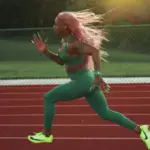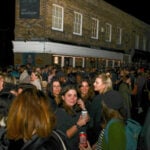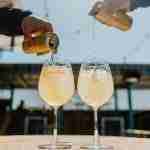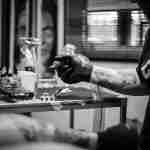Are lesbian haircuts and lesbian hairstyles actually a thing, what is a lesbian haircut, and does the ‘Lesbian Haircut’ exist anymore? We’ve decided to explore this topic a little more as it seems that over time the answers to these very questions have changed quite drastically.
Before we get into the history and evolution of the lesbian haircut. We’d like to clarify that this is not actually a thing! Although hair can be a huge part of someone’s identity, it really does not define your sexuality. You can have whatever haircut you want and be whoever you want to be at all times. Obvs!
That said, there seemingly was a time in history when haircuts were super important to the lesbian community, and we dive into the details below.

The Evolution of Lesbian Haircuts
Lesbian Haircuts in the 60s
In the 1960s, the prevailing societal norms and expectations often influenced hairstyles, including those within the LGBTQ+ community. During this time, the idea of a specific “lesbian haircut” wasn’t as prominent or defined as it might be perceived today. The 1960s marked a period of significant social change, activism, and the emergence of the LGBTQ+ rights movement, but discussions around distinct lesbian hairstyles were not as prevalent as in later decades.
Upgrade for ad free browsing.
Instead, LGBTQ+ individuals, including lesbians, often conformed to mainstream hairstyles and societal expectations to avoid discrimination and stigmatization. Many lesbians in the 1960s would have worn hairstyles that were culturally typical for women of that era, such as longer hair, various forms of bobs, beehives, flips, and even the pixie cut which gained some popularity.
It’s important to note that the concept of lesbian identity and visibility has evolved over time, and the emphasis on specific lesbian hairstyles as a form of self-expression and identification became more prominent in later decades, particularly from the late 1970s and onwards.
Article continues below.
In the 1960s, the LGBTQ+ community faced significant challenges, and openly expressing one’s sexual orientation could have severe consequences, including social ostracization, job loss, and legal persecution. As a result, LGBTQ+ individuals often conform to societal norms in terms of appearance, including hairstyles, to protect themselves and maintain a level of anonymity.
The distinct and varied lesbian hairstyles we might associate with specific eras, such as the “butch” or “femme” looks, became more pronounced in the LGBTQ+ community as visibility, acceptance, and pride grew in subsequent decades.
Lesbian Haircuts in the 70s
In the 1970s, the LGBTQ+ community, including lesbians, began to embrace more visible and distinct hairstyles as a form of self-expression and cultural identity. This era was marked by a burgeoning sense of pride and activism within the LGBTQ+ community, leading to the emergence of various styles that defied traditional gender norms. Here are some of the prevalent hairstyles among lesbians during the 1970s:
The Shag Cut: The shag haircut was a popular choice among lesbians in the 1970s. It was characterized by layers and feathering, often framing the face and providing a relaxed, casual appearance. The shag cut was versatile and could be adapted to suit different hair types and lengths.
The Pageboy: The pageboy haircut featured a straight, blunt cut at shoulder length or slightly shorter. This style was sleek and chic, reflecting the fashion of the time. Many lesbians embraced the pageboy for its simplicity and classic appeal.
The Feathered Flip: Feathering involves layering the hair to create a soft, feather-like effect. Combined with a flip, where the ends of the hair were curled or turned outwards, this style was trendy and exuded a carefree, youthful look.
The Afro: The Afro hairstyle gained immense popularity in the 1970s and was embraced by various communities, including lesbians. It symbolized pride in African heritage and defied traditional beauty standards. Many lesbians of colour proudly wore their hair in natural, voluminous Afros.
The Long, Flowing Locks: While short haircuts were prevalent, some lesbians chose to maintain longer hair in the 1970s. These longer styles often featured loose waves or curls, reflecting the overall free-spirited and bohemian vibe of the decade.
The Butch/Femme Contrast: The 1970s saw a continuation of the butch and femme dichotomy, where some lesbians embraced more traditionally masculine or feminine styles. Butch lesbians often sported shorter, more traditionally “masculine” cuts, while femmes might have worn longer, more conventionally “feminine” styles.
These hairstyles, along with the broader cultural and social movements of the 1970s, allowed lesbians to express their individuality, challenge gender norms, and assert their identities proudly. The 1970s were a pivotal time for the LGBTQ+ community, laying the groundwork for further visibility and acceptance in the decades to come.
Lesbian Haircuts in the 80s
In the 1980s, hairstyles underwent a radical transformation across society, and the LGBTQ+ community, including lesbians, were no exception. This era was characterized by bold, flamboyant styles that reflected the vibrant and dynamic spirit of the time. Here are some popular hairstyles among lesbians during the 1980s:
The Mohawk: The punk movement of the late 1970s and early 1980s brought about the iconic Mohawk hairstyle. It involved shaving the sides of the head and leaving a strip of longer, often spiked hair down the middle. It was a symbol of rebellion and non-conformity and was embraced by many within the LGBTQ+ community.
The Jheri Curl: The Jheri curl was a popular style among lesbians and other communities in the 1980s. It featured loose, glossy curls achieved through a special chemical treatment. The curls were often cascading and had a defined, wet look.
The Mullet: The mullet was characterized by short hair on the top and sides of the head and longer hair at the back. It was a unisex style and was particularly popular in the 1980s, reflecting the era’s love for contrasting lengths and bold looks.
The Side Ponytail: The side ponytail was a fun and playful hairstyle where the hair was gathered to one side of the head and secured with a scrunchie or hair tie. It was a casual and youthful style, often sported by lesbians and other individuals during this time.
Short and Spiky: Short, spiky hair was a prevalent choice, especially among those within the LGBTQ+ community. This edgy and rebellious style involved cutting the hair short and styling it into defined spikes, adding to the bold and energetic atmosphere of the 1980s.
Big, Teased Hair: Teased or backcombed hair was all the rage in the 1980s. Lesbians, like many others, would tease their hair to achieve volume, creating a larger-than-life, glamorous look that was iconic to the era.
The Bob: The bob, a classic haircut, was given a contemporary twist in the 1980s with layers and volume. It was a versatile style that lesbians could tailor to their preferences, whether opting for a sleek bob or a more textured, playful version.
The 1980s were a time of experimentation and self-expression, reflected not only in fashion but also in hairstyles. These distinctive and diverse styles allowed lesbians to showcase their unique identities and break free from traditional gender norms, embracing a bold, individualistic spirit.
Lesbian Haircuts in the 90s
The 1990s brought about a variety of hairstyles that were popular among lesbians, reflecting the fashion trends and cultural influences of that era. This decade was characterized by a blend of grunge, minimalism, and experimentation. Here are some of the prevalent hairstyles among lesbians during the 1990s:
The Short Crop: Short hair remained a popular choice in the 1990s, reflecting the influence of the 1980s punk and alternative scene. Many lesbians opted for short, cropped haircuts, often styled with a slightly messy, textured look for an edgy and rebellious appearance.
The Rachel Cut: Inspired by Jennifer Aniston’s character Rachel Green on the TV show “Friends,” the Rachel cut was a layered, mid-length hairstyle that became extremely popular. Many lesbians adopted this style for its versatility and ease of maintenance.
The Grunge Look: The Grunge movement heavily influenced the 1990s, and with it came a more relaxed, unstructured approach to hairstyles. Many lesbians and individuals within the LGBTQ+ community embraced the grunge look, featuring tousled, unkempt hair with a carefree vibe.
Dreadlocks: Dreadlocks gained popularity in the 1990s, and many lesbians adopted this style as a symbol of self-expression. Dreadlocks were often styled in various lengths and thicknesses, allowing for a personalized and unique look.
The Pixie Cut: The pixie cut made a resurgence in the 1990s, offering a chic and timeless option for lesbians. This short, classic style was low-maintenance and exuded confidence and modernity.
Curtain Bangs: Curtain bangs, characterized by longer, parted bangs that framed the face, were a trendy choice in the 1990s. Many lesbians incorporated this style into their haircuts for a softer, more feminine look.
Long, Loose Waves: Some lesbians chose to maintain longer hair in the 1990s, often styled with loose waves for a more relaxed, bohemian appearance. Long, flowing hair was a counterpoint to the short, edgy cuts of the era.
The 1990s embraced a wide range of styles, allowing lesbians to express themselves in various ways. From short, spiky cuts to longer, flowing styles, the hairstyles of the ’90s reflected the diversity and individuality of the LGBTQ+ community during this dynamic and transformative decade.
Lesbian Haircuts in the 00s
The 2000s saw a continuation of diverse hairstyles within the lesbian community, reflecting broader fashion trends and individual preferences. This decade was marked by a mix of retro revivals and emerging modern styles. Here are some popular hairstyles among lesbians during the 2000s:
The Faux Hawk: The faux hawk, a variation of the classic mohawk, gained popularity in the 2000s. It involved styling the hair to create a faux Mohawk-like look without actually shaving the sides. It was a bold, edgy style often embraced by lesbians seeking a rebellious and contemporary look.
The Textured Bob: The bob continued to be a favoured choice, but in the 2000s, it often featured more texture and movement. Layers and waves were added to provide a playful and dynamic appearance, appealing to lesbians looking for a stylish yet low-maintenance option.
Emo Hairstyles: Emo subculture influenced hairstyles in the 2000s, with many lesbians adopting these distinctive looks. Emo hairstyles were characterized by dark, bold colours, dramatic side-swept bangs, and asymmetry, reflecting an emotional and alternative aesthetic.
Long Layers: Long, layered hair was another prevalent style among lesbians in the 2000s. This versatile option allowed for different styling possibilities, from sleek and straight to tousled and wavy, catering to a range of tastes and preferences.
The Side-Swept Fringe: Side-swept fringes were a popular choice, complementing both short and long hair. This style involved sweeping the bangs to one side, framing the face and creating a soft, flattering look that appealed to many lesbians.
Buzz Cut: Some lesbians opted for a buzz cut, especially during the early 2000s, embracing a short and practical style. It was a bold choice that reflected confidence and a desire for minimalism.
Dyed Hair and Highlights: Experimenting with hair colour became increasingly popular in the 2000s. Many lesbians embraced vibrant or contrasting colours, highlights, or streaks, showcasing their personality and adding a playful element to their hairstyles.
The 2000s were a time of diverse expression and experimentation with styles, reflecting the changing attitudes towards gender, sexuality, and individuality. Lesbians, like everyone else, had a wide array of options to choose from, allowing them to express their unique identities and embrace various trends of the era.
Lesbian Haircuts in the 2010s
The Undercut: The undercut gained significant popularity in the early 2010s among women, including lesbians. It involved shaving or closely cutting the sides or back of the head while leaving the top longer. The undercut was celebrated for its edgy and bold look, allowing for various styles and designs.
The Pixie Cut: The pixie cut remained a classic and popular choice in the 2010s. This short, chic haircut was embraced by many lesbians for its timeless appeal and low-maintenance qualities. It provided a balance between sophistication and playfulness.
Long Beachy Waves: Long, loose waves were a prevalent style, offering a relaxed, bohemian look. Many lesbians opted for this hairstyle, which was versatile and could be dressed up or down for different occasions.
The Bob: The bob haircut continued to be a favourite, evolving with variations such as the lob (long bob) and the asymmetrical bob. The bob provided a modern and stylish option for lesbians seeking a sleek, structured look.
Natural Curls: Embracing natural curls and texture became increasingly popular during the 2010s. Many lesbians choose to wear their hair in its natural state, celebrating their unique curls and waves.
Braided Hairstyles: Braids, including fishtail, Dutch, and waterfall braids, were trendy during this decade. Lesbians often incorporated braids into their hairstyles for a playful and intricate look.
Colourful and Pastel Hair: Experimenting with hair colours, especially pastels and vibrant hues, became a major trend. Many lesbians showcased their creativity and individuality by dyeing their hair in a variety of shades, from soft pastels to bold neons.
Androgynous Styles: Androgynous hairstyles, which blur the lines between traditional male and female cuts, gained popularity. These styles allowed for gender expression that defied traditional norms, providing a sense of empowerment and freedom.
The 2010s were a transformative period, marked by an emphasis on self-expression and breaking free from conventional beauty standards. Lesbians, like everyone else, embraced a range of styles that allowed them to express their unique identities, ultimately contributing to a more inclusive and diverse representation of beauty and individuality.
Lesbian Haircuts 2023
In today’s world, the message is clear: embrace your authenticity. Hairstyles are a form of self-expression and identity, irrespective of gender or sexual orientation. Lesbian haircuts have transitioned from being boxed into a stereotype to representing empowerment, self-acceptance, and the beauty of diversity.
It’s crucial to celebrate and support individuals in their journey of self-discovery, allowing them to express themselves freely and authentically. Let’s continue to break down barriers, challenge stereotypes, and create a world where everyone feels seen, heard, and loved.
So, whether you choose a short haircut, long locks, or anything in between, remember that what matters most is your confidence and how you wear your beautiful, unique self. Stay fabulous, and keep shining!
Happy styling,
Team Nonchalant x




